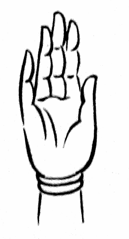Abhayamudra on:
[Wikipedia]
[Google]
[Amazon]


 The Abhayamudrā "gesture of fearlessness" is a
The Abhayamudrā "gesture of fearlessness" is a

 The Abhayamudrā "gesture of fearlessness" is a
The Abhayamudrā "gesture of fearlessness" is a mudrā
A mudra (; sa, मुद्रा, , "seal", "mark", or "gesture"; ,) is a symbolic or ritual gesture or pose in Hinduism, Jainism and Buddhism. While some mudras involve the entire body, most are performed with the hands and fingers.
As wel ...
(gesture) that is the gesture of reassurance and safety, which dispels fear and accords divine protection and bliss in Buddhism and other Indian religions
Indian religions, sometimes also termed Dharmic religions or Indic religions, are the religions that originated in the Indian subcontinent. These religions, which include Hinduism, Jainism, Buddhism, and Sikhism,Adams, C. J."Classification of ...
. The right hand is held upright, and the palm is facing outwards. This is one of the earliest mudrās found depicted on a number of Hindu
Hindus (; ) are people who religiously adhere to Hinduism.Jeffery D. Long (2007), A Vision for Hinduism, IB Tauris, , pages 35–37 Historically, the term has also been used as a geographical, cultural, and later religious identifier for ...
, Buddhist
Buddhism ( , ), also known as Buddha Dharma and Dharmavinaya (), is an Indian religion or philosophical tradition based on teachings attributed to the Buddha. It originated in northern India as a -movement in the 5th century BCE, and ...
, Jain
Jainism ( ), also known as Jain Dharma, is an Indian religion. Jainism traces its spiritual ideas and history through the succession of twenty-four tirthankaras (supreme preachers of ''Dharma''), with the first in the current time cycle being ...
and Sikh
Sikhs ( or ; pa, ਸਿੱਖ, ' ) are people who adhere to Sikhism, Sikhism (Sikhi), a Monotheism, monotheistic religion that originated in the late 15th century in the Punjab region of the Indian subcontinent, based on the revelation of Gu ...
images.
The abhayamudrā (施無畏印) represents protection, peace, benevolence and the dispelling of fear. The Hindu god Nataraja
Nataraja () also known as Adalvallaan () is a depiction of the Hindu god Shiva as the divine cosmic dancer. His dance is called Tandava.''Encyclopædia Britannica'' (2015) The pose and artwork are described in many Hindu texts such as the ''T ...
is depicted with the second right hand making the Abhaya Mudra, bestowing protection from both evil and ignorance to those who follow the righteousness of dharma. In Theravada Buddhism
''Theravāda'' () ( si, ථේරවාදය, my, ထေရဝါဒ, th, เถรวาท, km, ថេរវាទ, lo, ເຖຣະວາດ, pi, , ) is the most commonly accepted name of Buddhism's oldest existing school. The school' ...
, it is usually made with the right hand raised to shoulder height, the arm bent and the palm facing outward with the fingers upright and joined and the left hand hanging down while standing. In Thailand and Laos, this mudra is associated with the Walking Buddha, often shown having both hands making a double abhayamudrā that is uniform.
The abhayamudrā was probably used before the onset of Buddhism as a symbol of good intentions proposing friendship when approaching strangers. In the art of Gandhara
Gandhāra is the name of an ancient region located in the northwestern region of the Indian subcontinent, more precisely in present-day north-west Pakistan and parts of south-east Afghanistan. The region centered around the Peshawar Vall ...
, it is present when showing the action of preaching. It was also used in China during the Northern Wei
Wei (), known in historiography as the Northern Wei (), Tuoba Wei (), Yuan Wei () and Later Wei (), was founded by the Tuoba (Tabgach) clan of the Xianbei. The first of the Northern and Southern dynasties#Northern dynasties, Northern dynasties ...
and Sui eras of the 4th and 7th centuries.
The gesture was used by Gautama Buddha
Siddhartha Gautama, most commonly referred to as the Buddha, was a wandering ascetic and religious teacher who lived in South Asia during the 6th or 5th century BCE and founded Buddhism.
According to Buddhist tradition, he was born in Lu ...
to subdue the elephant when attacked by a drunk elephant set off by Devadatta
Devadatta was by tradition a Buddhist monk, cousin and brother-in-law of Gautama Siddhārtha. The accounts of his life vary greatly, but he is generally seen as an evil and divisive figure in Buddhism, who led a breakaway group in the ea ...
(some says by Ajātasattu),From Dhammapada
The Dhammapada (Pāli; sa, धर्मपद, Dharmapada) is a collection of sayings of the Buddha in verse form and one of the most widely read and best known Buddhist scriptures. The original version of the Dhammapada is in the Khuddaka ...
, Buddhacharita, and Arśapraśamanasūtra as shown in several fresco
Fresco (plural ''frescos'' or ''frescoes'') is a technique of mural painting executed upon freshly laid ("wet") lime plaster. Water is used as the vehicle for the dry-powder pigment to merge with the plaster, and with the setting of the plaste ...
s and scripts. In Mahayana Buddhism
''Mahāyāna'' (; "Great Vehicle") is a term for a broad group of Buddhist traditions, texts, philosophies, and practices. Mahāyāna Buddhism developed in India (c. 1st century BCE onwards) and is considered one of the three main existing bra ...
, deities often paired it with another mudrā using the other hand.
References
Bibliography
*External links
* Mudras Hindu symbols Buddhist symbols Jain symbols Sikh symbols Indian iconography {{Hindu-theo-stub